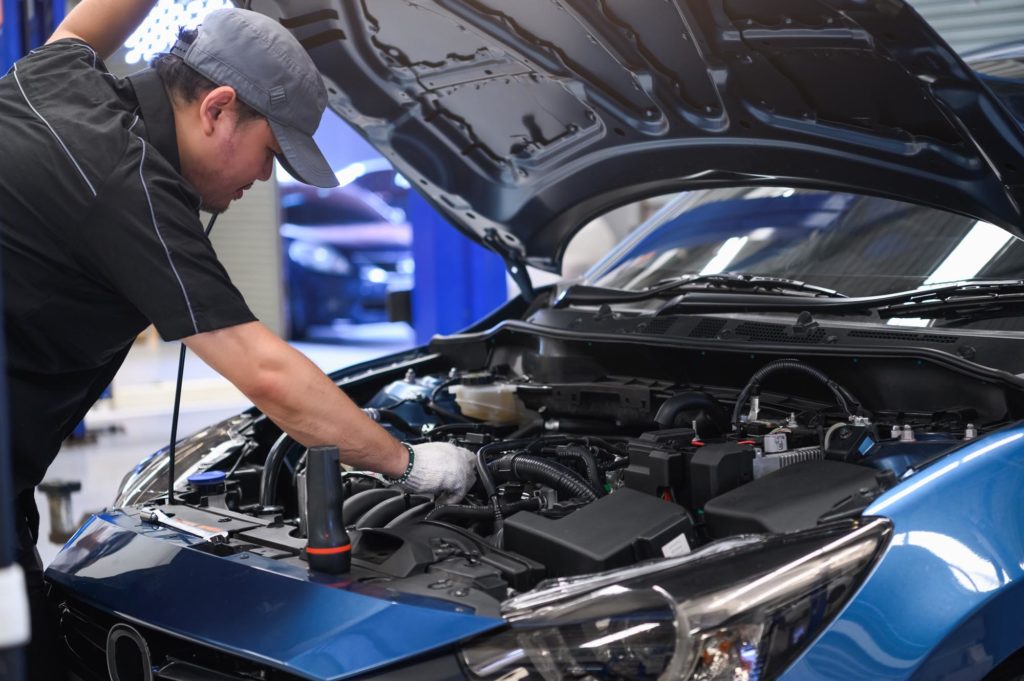All vehicles have one or more exhaust manifolds that route spent exhaust gases away from the engine’s cylinder head(s) and toward the exhaust pipe.
Engines with a ‘V’ or flat configuration have two exhaust manifolds, whereas engines with an inline or straight design have just one. Each manifold has a corresponding gasket that forms a seal between the manifold and the cylinder head.
Most engine exhaust manifolds are made from heavy-duty cast iron or stainless steel. They need to be made from strong materials because they’re exposed to tremendous heat. But overtime, a manifold can warp or crack due to thermal stress, resulting in an exhaust leak. Exhaust leaks can also develop from failed manifold gaskets and broken mounting studs.

Exhaust Manifold Leak Symptoms
The signs of exhaust leaks are often very apparent. If your car is suffering from a leaking exhaust manifold or manifold gasket, you’ll likely notice one or more of the following symptoms:
Ticking or Tapping Noise
A leaking exhaust manifold will almost always create a ticking or tapping noise. Often, the sound is more pronounced upon startup when the engine and the manifold are both cold. The noise may diminish or disappear once the engine warms up and the manifold expands, closing off the leak.
The videos below demonstrates a typical exhaust manifold leak sound:
Illuminated Check Engine Light
An exhaust leak can cause your car’s oxygen sensors to interpret a lean running condition—an engine air-fuel mixture with too little fuel—that doesn’t really exist. The sensors then notify the engine computer of the perceived lean condition, prompting the computer to turn on the check engine light.
In some extreme cases, the computer may also respond by richening up the engine’s air-fuel mixture enough to cause performance problems, such as rough running and misfiring.
Exhaust Odors
If your car has a leaking exhaust manifold, you may notice an exhaust odor emanating from the engine bay. It’s also possible for the leak to cause hazardous carbon monoxide fumes to enter the passenger compartment.
Visible Damage
The studs (or bolts) that fasten the manifold to the cylinder head can eventually weaken and fail, causing an exhaust leak. It’s also possible for a warped exhaust manifold to force the studs to over-extend and break off.
Other signs of a leaking exhaust manifold (or gasket) include black soot and/or melted components around the origin of the leak. You may also be able to see visible cracks in the manifold.
Loss of Acceleration and Power
If you notice a drop in your vehicle’s performance, then you might be dealing with an exhaust leak. A leak in the exhaust manifold can negatively affect your engine, preventing it from accelerating. The longer you ignore the issue, the more power your engine loses.
Reduced Fuel Economy
An exhaust manifold leak can also interfere with your engine’s air-to-fuel ratio, causing your vehicle to use more fuel than necessary. Your engine becomes less efficient, forcing you to spend more on gas.
Unusual Vibrations
If you notice any unusual vibrations whenever you accelerate, you might have a leak in the exhaust system. Exhaust gases leaking out of the pipes can create a force that causes the steering wheel or gas pedal to vibrate.

How to Find an Exhaust Manifold Leak
To prevent yourself from replacing the wrong component, you should first figure out how to find the exhaust leaks. Leaks elsewhere in the exhaust system can present the same symptoms as a leaking exhaust manifold. That’s why it’s important to verify that the leak is coming from the manifold before attempting any repairs.
If you think an exhaust leak has formed, the first thing you should ask is “What does an exhaust leak sound like?” You can often find an exhaust manifold leak by listening to the vehicle and performing a visual inspection.
Now, how do you find an exhaust leak with this method? First, start the engine cold and listen for the telltale ticking or tapping sound of an exhaust leak. Once you’ve traced the noise to the manifold, look for confirmation of an exhaust leak, such as soot stains and missing studs. Components (e.g., spark plug wires) close to the exhaust leak may also be melted.

In some cases, you may need to remove the exhaust manifold to confirm that it has failed. Once the manifold is removed, you can visually inspect it for hairline cracks that would warrant replacement.
If you don’t see any cracks, you’ll want to check the manifold for warpage with a precision straightedge and a flashlight.
Start by cleaning any old gasket material from the manifold. Then, lay the straightedge across the manifold. Shine your flashlight at the point where the manifold and straightedge meet—if the manifold is warped, you’ll see light shining through from underneath the straight edge.
How to Fix an Exhaust Manifold Leak
To fix an exhaust manifold leak, you’ll need to replace whatever component is causing the problem. Depending on the situation, that could be the manifold itself, the manifold gasket, or broken mounting studs.

Common Causes of Exhaust System Leak
Fixing an exhaust manifold leak can be a hassle. Knowing how to prevent leaks can save you from hefty repair bills, so keep an eye out for the things that can cause them:
Corrosion
Constant exposure to moisture and road salt can cause several parts of your exhaust system to rust. This can eventually lead to cracks or holes where leaks can develop.
Driving on Rough Roads
As much as possible, avoid driving over potholes and rocky terrain. Driving over rough roads can cause your exhaust system to shake and weaken. Rocks and other road debris can also damage the exhaust system, creating small cracks.
Worn Components
When a gasket between exhaust components wears over time, it can cause a leak to seep through. Similarly, a worn hanger that’s meant to secure your exhaust system can also fall off, causing several parts to bounce and vibrate as you drive.
Can You Drive With an Exhaust Manifold Leak?
If your car has an exhaust manifold leak, you (or your mechanic) should fix the issue as soon as possible. A leaking manifold can eventually lead to additional problems, such as premature catalytic converter failure.
What’s more, a leaking exhaust manifold can be a health hazard if the issue results in carbon monoxide entering the passenger compartment.
How much does it cost to replace an exhaust manifold?
If you choose to have a professional replace your car’s exhaust manifold, you can usually expect to pay somewhere between $500 and $1500 to get the job done. Of course, the exact cost will depend on various factors, such as the year, make, and model of your vehicle.
You can save money by replacing the exhaust manifold yourself if you have the tools and the know-how. CarParts.com has a wide variety of replacement exhaust manifolds available for various makes and models.
Check out this video for tips on how to replace your exhaust manifold:
Any information provided on this Website is for informational purposes only and is not intended to replace consultation with a professional mechanic. The accuracy and timeliness of the information may change from the time of publication.































